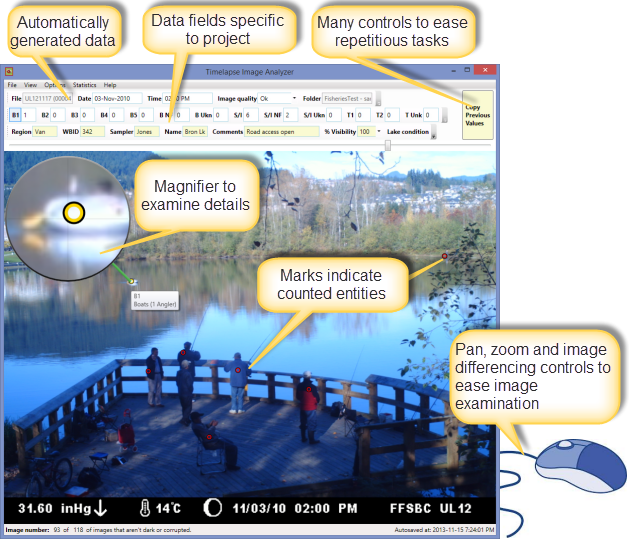Timelapse: Brief Overview
Brief overview of the Timelapse2 Image Analyzer. See Getting Started for a step by step description of how to use the software.

Motivation.
Analyzing images collected on remote cameras is laborious for a variety of reasons.
- the number of images can easily number in the thousands
- entities of interest on the image can be extremely small (e.g., a few pixels) and hard to spot
- when there are many entities, its easy to lose count of what has been counted versus what hasn't been counted
- data entry can be very repetitive
- non-interesting changes in an image may occur due to many reasons, e.g., wind, sun, clouds, shadows.
How the Timelapse2 Image Analyzer Helps.
The Timelapse2 Image Analyser is designed to help scientists in several ways.
- an easy interface for entering per image data (i.e., counting things, textual notes, selecting from options), where codes are tracked per image
- data is saved and associated with its image, so that the scientist can review, modify or add onto their work at any time
- through a scientist-defined file, one can specify input codes of interest; the interface will automatically create user interface controls associated with those codes, including labelled
- freeform text comments
- choice selections via a menu
- counts by either entering a number or clicking on entities in an image (which marks that spot to avoid counting errors)
- easy deletion of multiple images that are no longer wanted
- In addition to the above, the system automatically generates certain coding information from the source images
- filename
- folder
- date the photo was taken (if it is included by the camera in the image metadata)
- time the photo was taken (if it is included by the camera in the image metadata)
- image quality, as either OK, or Corrupted (if not usable) or Dark (for detecting nighttime shots)
- For viewing and analyzing images for entities of interest, the scientist can rapidly
- navigate through a large sequence of images
- move back and forth between several images in a sequence, which highlights changes
- compare the visual differences between this and surrounding images, which makes some things 'pop out' that are otherwise hard to see
- filter images to see only non-dark valid images, or all images, or dark and corrupted images only
- pan and zoom images
- use a magnifying glass to quickly look at details
- viewing and entering data for multiple images at a time
This is just a short list. There are more features than these.